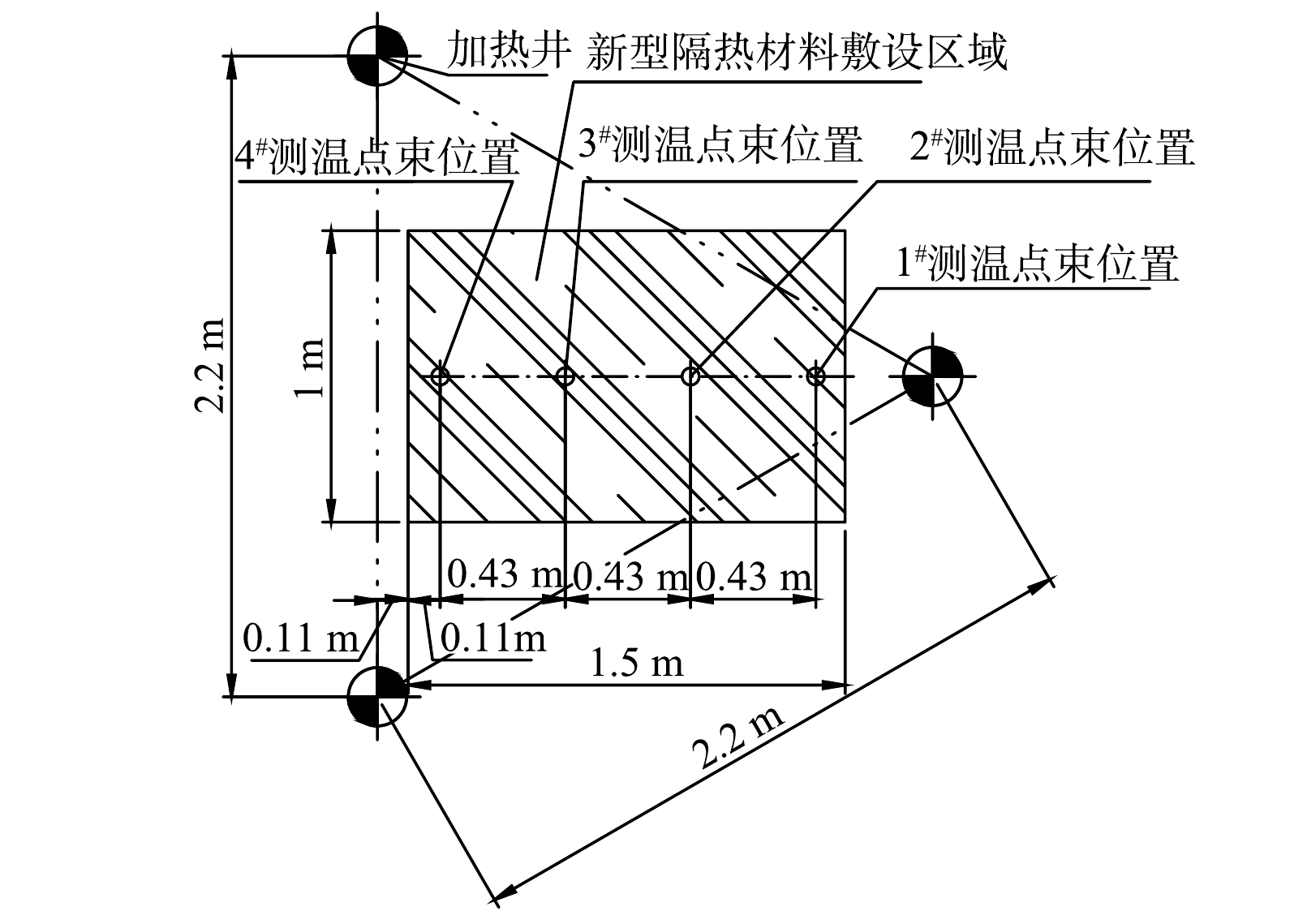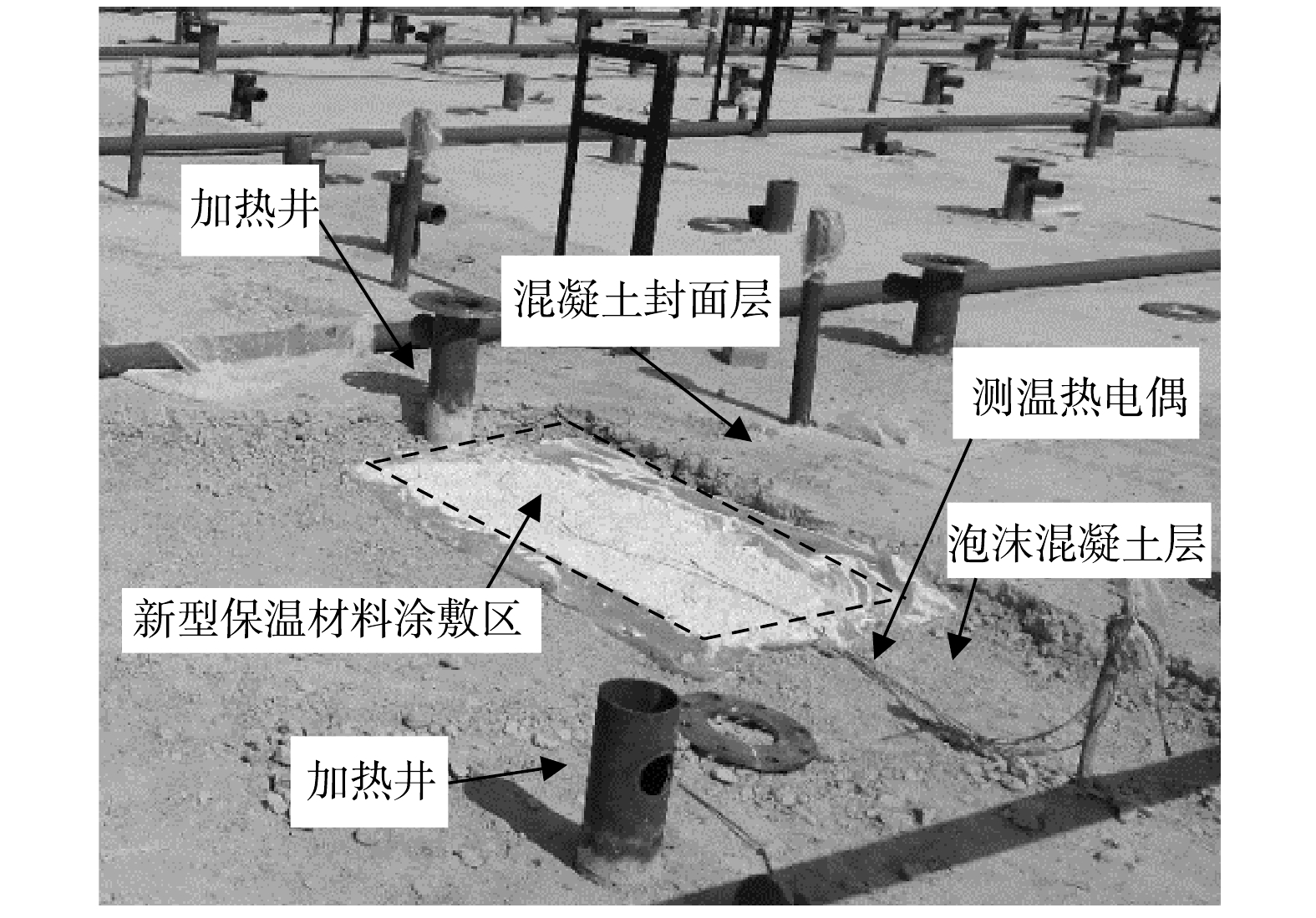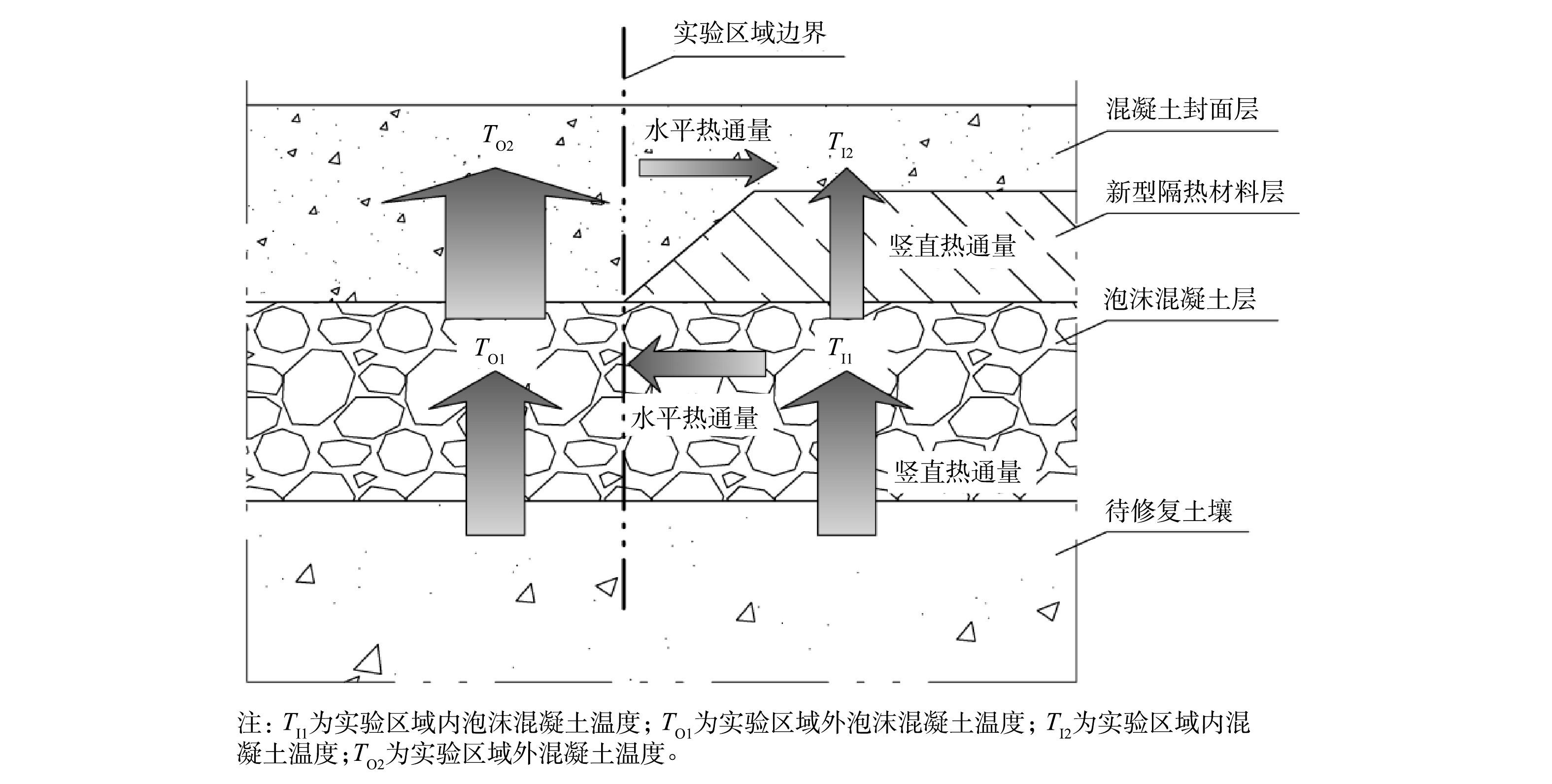-
随着我国产业政策的调整,对城市核心区域及附近污染重、能耗大、效益差的工业企业开展了有重点、分层次、分区域、分时段的搬迁、改造或关闭,因而全国各大中城市出现了大量因工厂搬迁导致的有机污染物场地[1-3]。原位热修复技术因其在修复低渗透性土壤、污染深度较深且有机物污染严重的场地中具有独特优势,故被广泛应用于有机污染场地修复[4-8]。
无论是燃气热修复技术还是电热修复技术[9-11]都属于热传导[12-13]式热修复技术。热传导式热修复主要是通过热传导的方式,将有机污染场地中的土壤升温,以促使有机污染物挥发,由固相、液相向气相转化,最终对其进一步收集并去除[14-16]。为达到较高的去除效率,土壤需加热到较高温度[17],即达到或接近污染物的沸点[18-19],因此,原位热修复技术能源消耗较大。若热修复场地不采取相应的隔热措施,不但会造成场地表面温度过高,导致后续运营工作无法开展,而且会因场地表面散热而浪费大量能量。因此,表面阻隔工艺的使用在热修复工程应用中是一个不可或缺的组成部分。
目前,岩棉板、加气砖和泡沫混凝土是常用的热修复场地表面阻隔材料[20-21],但其隔热性能一般,无法完全满足现场需求。其中,岩棉板在施工过程的拼接缝难以平整对齐,同时施工人员需要穿防护服,而且岩棉板敷设后的封面层也不易施工;加气砖很难将热修复场区敷设平整,热修复场区存在凹处,易积聚雨水,影响隔热效果;泡沫混凝土因其制备特点,需要现场拌合,且拌合过程会导致扬尘污染。
为了减少场地的热量散失,提高能源利用率,研发新型隔热材料尤为重要[22-23]。纳米中空陶瓷微珠隔热涂料是一种在硅酸盐无机溶液成膜物质中加入陶瓷或玻璃等材质的空心微米级微珠配制而成的新型隔热材料。由于微珠腔体几何体积很小,微珠内部空气在高温受热后,热对流作用可忽略不计;且微珠体积小、紧密排列,微珠之间同样存在微米级的空气层,进一步减弱了热对流作用。同时,以较低导热系数的无机成膜物质作为支撑,共同构造了以静态空气层和无机成膜物质为涂层的绝热屏蔽层[24-26]。本研究采用新型隔热材料作为原位热修复技术的表面阻隔材料,通过现场实验,分析该材料隔热性能及受施工方法、实验区域尺寸等的因素影响。
-
本实验选用北京志盛威华化工有限公司生产的ZS-1耐高温隔热保温涂料。这是一种水性纳米中空陶瓷微珠隔热涂料,采用硅酸盐无机溶液作为涂料成膜物,纳米空心陶瓷微珠作为填料,硅酸铝纤维作为结构骨料。新型隔热材料涂层的导热系数仅为0.033 W·(m·K)−1。
泡沫混凝土是通过发泡系统将发泡剂用机械方式充分发泡,并将泡沫与水泥浆均匀混合,然后经过发泡机的泵送系统进行现浇施工或模具成型,经自然养护所形成的一种含有大量封闭气孔的新型轻质保温材料。泡沫混凝土的实验室测量的导热系数约为0.080~0.135 W·(m·K)−1 [27],工程上该系数一般为0.19~0.22 W·(m·K)−1 [28]。新型隔热材料的导热系数是泡沫混凝土的17%以下,具有更好的隔热性能。此外,该材料还具有更好的高温性能,并有较强的涂膜硬度和强度。
-
本实验位于某原位燃气热修复(gas thermal remediation, GTR)场地。加热井间距2.2 m,采用三角形网格布置。实验区域选定在修复场地中间区域,以避免场地边界效应对实验结果的影响。实验区域内自下而上分别为泡沫混凝土层(厚度0.15 m)、新型隔热材料层(厚度0.003 m)、混凝土封面层(厚度0.1 m),各层分布详见图1。实验区域外不敷设新型隔热材料,仅敷设泡沫混凝土层(厚度0.15 m)、混凝土封面层(厚度0.1 m)。在图2所示的测温点束位置处,按图1所示的纵向分布位置布设测温点。在硬化后的泡沫混凝土层上,敷设数层被水充分浸润的玻璃纤维布,之后再涂敷新型隔热材料;经过3 d的阴干后,待新型材料材料外表坚硬且无裂纹,则可认为材料充分干燥;最后,进行混凝土封面施工。实验区域施工现场如图3所示。
-
在原位热修复过程中,当最不利加热位置的深层土壤维持在约100 ℃时,加热过程会出现温升平台现象。在温升平台阶段,加热区域内的加热井附近土壤由于已经干燥,该部分土壤温度会高于水的沸点。但其余绝大部分土壤仍处于含水状态,从而其温度会维持在约100 ℃,因此土壤内部温度在此阶段内变化较小。在此阶段,处于相近的环境条件下的表层土壤会呈现相近的温度梯度。
实验时,在温升平台阶段测量连续数个晴天气温最高时刻各测温点的温度。如果各测点温度相近,可以判定加热场地的土壤整体处于相对平稳的状态。此时,影响表层阻隔层性能的主导因素为环境条件。因此,可选择此阶段作为实验阶段。
-
在温升平台阶段的连续5个晴天气温最高时刻(实验阶段的日平均最高气温为30 ℃),记录各测温点温度,各层各测温点温度数据详见表1。由于各测点温度连续5 d测量的温度相近,可以判定此时加热场地的土壤整体处于一个相对平稳的状态。因此,在此阶段测量不同环境条件下各测点温度数据可以用来判断不同环境条件对隔热材料保温性能的影响。
为了分析昼夜环境、降雨对各层材料性能的影响,在实验阶段对夜间、降雨阶段各测温点温度也进行了记录。试验阶段的环境气温为15 ℃,夜间环境下各测温点温度见表2。在实验阶段后2 d,有1次较大的降雨过程。为探讨降雨阶段对表层阻隔层的性能影响,也对降雨时各测温点温度进行了记录,记录时环境气温约为22 ℃。降雨过程的测量数据详见表3。
由于在实际施工条件下各种材料的导热系数难以准确获得,因此,通过计算材料上下层温差与材料厚度之比,得出各材料各处的温度梯度,从而对各种材料的隔热性能进行评价。根据表1、表2和表3的温度数据,计算出不同条件下热影响区域外各层材料各测温点束位置的温度梯度,温度梯度数据见表4。
如图2所示,1#测温点束距离加热井最近,该测温点束区域受加热井的影响大于其他外界环境条件的影响,表现出的隔热特点与其他区域不同。在本实验中,加热井对表层阻隔的影响半径介于1#和2#测温点束位置之间,所以加热井热影响区域半径至少为0.53 m。热影响区域内的新型隔热材料上下层间维持了较大温度梯度,约为8 366.7~9 073.3 ℃·m−1,最高可达13 600 ℃·m−1,具有较佳的隔热性能。因此,在影响区域敷设新型隔热材料可以明显减少修复区域的表层散热。新型隔热材料晴天条件下的温度梯度最高,约为960~1 560 ℃·m−1。在雨天环境下,新型隔热材料温度梯度约为633.3~1 333.3 ℃·m−1。夜间环境温度梯度最低,约为433.3~800 ℃·m−1。泡沫混凝土的温度梯度一般不超过150 ℃·m−1。不同环境条件下,新型隔热材料的隔热性能均高于传统隔热材料泡沫混凝土。
-
1)影响泡沫混凝土下侧温度的原因。泡沫混凝土下层为修复土壤,该处温度分布取决于深层土壤温度分布。实验阶段处于温升平台阶段,1#点位靠近加热井附近,深层土壤温度较高,此处泡沫混凝土下侧温度也较高。而其余深层温度普遍维持在100 ℃左右,因此表层温度差异较小。而且,该修复场地泡沫混凝土下侧设置了水平抽提管。由于水平抽提管的抽提作用,使得土壤与泡沫混凝土的间隙内有大量流动气流,进一步缩小了各处温差。加之全场地敷设的泡沫混凝土具有较低的导热系数和较高的比热容,故除加热井影响区域外,造成泡沫混凝土层下侧温度的空间差异性较小。
2)影响新型隔热材料上侧温度的原因。如图3所示,新型隔热材料上侧是混凝土封面层,而封面层不具有保温作用。因此,无论是否在加热井影响区域内,新型隔热材料上侧温度在降雨和夜间环境均有所降低。降雨条件下,混凝土表层受大量雨水冲刷,因此,新型隔热材料上侧温度降低更多。
3)影响新型隔热材料下侧温度的原因。如图3所示,新型隔热材料下侧即为泡沫混凝土上侧。该处位于保温层之间,具有较好的保温条件。在加热井热影响区域内,新型隔热材料下侧温度主要受加热井的影响,因此,在不同环境条件下温度相近,且均为各组实验中的最高温度。在加热井热影响区域外,新型隔热材料下侧与上侧受环境条件影响的相同。
4)新型隔热材料隔热性能的特点。由本实验可知,新型隔热材料在热影响区域内呈现出较佳的隔热性能,材料上下层间维持了较大温差,明显降低了加热井热影响区域的表层散热。在热影响区外,新型隔热材料也具有较好的隔热性能。新型隔热材料层在晴天环境和雨天环境下隔热性能相近,但夜间环境隔热性能较低。造成新型材料隔热性能的差异性可能是由于实验中敷设区域较小,产生了较强的边界效应。
5)边界效应。表层阻隔实验区域边界效应的成因如图4所示。由于实验区域内外保温性能的不同,造成在边界附近温度具有TI1>TO1>TO2>TI2的特征。由于在泡沫混凝土层内只存在水平和竖直方向的热量传递,所以泡沫混凝土的热通量等于泡沫混凝土层的水平热通量与竖直热通量之和。同时,新型材料敷设厚度很薄,其水平方向的热通量可以忽略,新型材料的竖直热通量近似等于泡沫混凝土的竖直热通量。
在温升平台阶段,晴天环境为气温最高时段,表层对流散热小,混凝土层温度接近环境温度。晴天环境下实验区域内外侧混凝土层温度TI2与TO2间温差最小,表面阻隔层边界处的水平热通量最小。在降雨条件下,场地表层受大量雨水冲刷,地表降温明显,但内外侧混凝土层温度TI2与TO2间温差不明显。在夜间条件下,由于环境气温较低,混凝土层散热量大,因此,内外侧混凝土层温度TI2与TO2间有明显温差。新型材料层在晴天环境和雨天环境下隔热性能相近,而由于边界效应造成了夜间环境隔热性能较低。
在本实验中,3#点束位于靠近三角形加热区域的几何中心处,距离所有加热井最远,为最不利加热位置。因此,理论上3#点束各层温度应该是同层所有测温点束中最低的。同样由于新型隔热材料敷设区域边界效应的影响,最靠近敷设区域边界的4#点束区域的水平方向散失热量将大于其他区域,所以除个别测温点外,4#点束区域的温度均为该层最低温度。
-
1)加热井热影响区域内的新型隔热材料的温度梯度约为8 366.7~9 073.3 ℃·m−1,最高可达13 600 ℃·m−1,具有极佳的隔热性能。加热井热影响区域半径至少为0.53 m。在影响区域敷设新型隔热材料可以显著减少修复区域的表层散热。
2)在加热井热影响区域外,新型隔热材料晴天条件下的温度梯度最高,约为960~1 560 ℃·m−1。在雨天环境,新型隔热材料温度梯度约为633.3~1 333.3 ℃·m−1。夜间环境温度梯度最低,约为433.3~800 ℃·m−1。泡沫混凝土的温度梯度一般不超过150 ℃·m−1。在不同环境条件下,新型隔热材料的隔热性能均高于传统隔热材料泡沫混凝土。
一种新型隔热材料在原位土壤热修复工程中的表面阻隔效应
Surface barrier effects of a new thermal insulation material in in-situ soil thermal remediation engineering site
-
摘要: 对原位热修复场地表层土壤采用有效的隔热措施,有助于实现节能降耗。纳米中空陶瓷微珠水性隔热涂料是一种新型隔热材料,导热系数低,可作为原位热修复修复场地的表面阻隔材料。通过现场实验,探究了该涂料的隔热性能及其受施工方法、实验区域尺寸等因素的影响。结果表明,在加热井热影响区域内,新型隔热材料的温度梯度最高可达13 600 ℃·m−1;加热井热影响区域半径至少为0.53 m,在影响区域敷设新型隔热材料可以显著减少修复区域的表层散热。新型隔热材料的温度梯度均高于传统泡沫混凝保温材料,在影响区域外最高可达1 560 ℃·m−1;在晴天环境条件下,新型隔热材料的温度梯度高于雨天和夜晚环境条件。新型隔热材料对原位热修复场地具有良好的隔热保温效果。Abstract: In order to reduce energy consumption, effective thermal insulation measures were adopted in the surface soil of in-situ thermal remediation site. A new type of water-based thermal insulation coating of nano hollow ceramic microsphere (hereinafter referred to as “new insulation material”) which had low thermal conductivity, could be used as surface barrier material in an in-situ thermal remediation engineering site. The heat insulation performance was analyzed by calculating the material temperature gradient under different environmental conditions, and the effects of temperature gradients of the new thermal insulation material caused by the construction method and the experimental area size had been also analyzed. The results showed that the temperature gradient of the new insulation material in the thermal influence area of heating well, which the minimum radius was 0.53 m, could be 1 3600 ℃·m−1. Covering new insulation material in the influence area could significantly reduce the surface heat dissipation. Outside the influence area, the temperature gradient of the new insulation material on sunny days could be 1 560 ℃·m−1, was higher than that in night and rainy day. Under sunny environmental conditions, the temperature gradient of the new insulation material was higher than that of rainy and night environmental conditions. Thus, the application of new insulation material in an in-situ thermal remediation engineering site would have a good thermal insulation effect.
-
表 1 各测温点温度
Table 1. Temperatures of each measurement points
纵向测温点束位置 测量时间 测温点束温度/℃ 1# 2# 3# 4# 加热土壤与泡沫混凝土之间 第1天 85.4 65.6 60.7 58.9 第2天 86.1 65.3 60.9 59.9 第3天 82.4 65.7 59.5 59.4 第4天 83.7 65.4 61.3 60.2 第5天 83.6 66.6 61.6 62.9 泡沫混凝土与新型隔热材料之间 第1天 90.3 60.1 54.7 53.6 第2天 92.1 60.3 54.2 52.5 第3天 91.3 59.8 54.4 53.1 第4天 89.7 58.2 54.0 52.9 第5天 93.0 59.5 53.9 53.8 新型隔热材料与混凝土层之间 第1天 68.7 55.3 51.6 49.9 第2天 62.5 55.4 51.5 50.0 第3天 63.1 54.4 50.3 48.7 第4天 62.6 54.5 50.4 49.5 第5天 63.4 54.9 53.0 50.2 表 2 夜间各测温点束各层温度数据表
Table 2. Temperatures of each measurement bundles in night
测温点束位置 测温点束温度/℃ 1# 2# 3# 4# 加热土壤与泡沫混凝土之间 67.9 63.4 60.0 59.7 泡沫混凝土与新型隔热材料之间 86.0 50.4 49.0 49.0 新型隔热材料与混凝土层之间 60.9 49.1 47.3 46.6 表 3 降雨阶段各测温点束各层温度数据表
Table 3. Temperatures of each measurement bundles in rainy time
测温点束位置 测温点束温度/℃ 1# 2# 3# 4# 加热土壤与泡沫混凝土之间 73.6 64.3 63.6 59.8 泡沫混凝土与新型隔热材料之间 90.0 45.4 42.2 41.3 新型隔热材料与混凝土层之间 49.2 41.4 40.3 38.1 表 4 不同条件下热影响区域外各层材料的温度梯度
Table 4. Temperature grades of outside heat affected area under different conditions
℃·m−1 纵向测温点束 晴天 夜间 雨天 泡沫混凝土 新型隔热材料 泡沫混凝土 新型隔热材料 泡沫混凝土 新型隔热材料 2# 40.9 1 560 86.7 433.3 126 1 333.3 3# 43.7 960 73.3 566.7 142.7 633.3 4# 47.2 1 173.3 71.3 800 123.3 1 066.7 -
[1] HAN L, QIAN L B, YAN J C, et al. A comparison of risk modeling tools and a case study for human health risk assessment of volatile organic compounds in contaminated groundwater[J]. Environmental Science and Pollution Research, 2016, 23(2): 1234-1245. doi: 10.1007/s11356-015-5335-4 [2] YANG H, HUANG X, THOMPSON J R, et al. China's soil pollution: urban brownfields[J]. Science, 2014, 344(6185): 691-692. [3] KINGSTON J L T, DAHLEN P R, JOHNSON P C. State-of-the-practice review of in situ thermal technologies[J]. Groundwater Monitoring & Remediation, 2010, 30(4): 64-72. [4] 骆永明. 污染土壤修复技术研究现状与趋势[J]. 化学进展, 2009, 21(2/3): 558-565. [5] 吴嘉茵, 方战强, 薛成杰, 等. 我国有机物污染场地土壤修复技术的专利计量分析[J]. 环境工程学报, 2019, 13(8): 2015-2024. doi: 10.12030/j.cjee.201812195 [6] 张学良, 廖朋辉, 李群, 等. 复杂有机物污染地块原位热脱附修复技术的研究[J]. 土壤通报, 2018, 49(4): 993-1000. [7] 康绍果, 李书鹏, 范云. 污染地块原位加热处理技术研究现状与发展趋势[J]. 化工进展, 2017, 36(7): 2621-2631. [8] MIHAILA M, HOTNOG C, THEODOR V, et al. In situ thermal treatment (ISTT) for source zone remediation of soil and groundwater[J]. British Medical Journal, 2013, 31(31): 482-484. [9] HEGELE P R, MUMFORD K G. Gas production and transport during bench-scale electrical resistance heating of water and trichloroethene[J]. Journal of Contaminant Hydrology, 2014, 165: 24-36. doi: 10.1016/j.jconhyd.2014.07.002 [10] HIESTER U, MULLER M, KOSCHITZKY H, et al. In situ thermal treatment (ISTT) for source zone remediation of soil and groundwater[J]. British Medical Journal, 2013, 31: 482-484. [11] 刘伟, 汪华安, 尚浩冉, 等. 有机污染场地原位电法热脱附修复技术综述[C]// 《环境工程》编委会. 环境工程2018年全国学术年会论文集(下册).北京, 2018:746-750. [12] JOHANSEN O. Thermal conductivity of soils[D]. Trondheim, Norway: University of Trondheim, 1975. [13] FAROUKI O T. Thermal properties of soils, CRREL Monograph 81-1[M]. Hanover, NH: US Army Corps of Engineers, Cold Regions Research and Engineering Laboratory, 1981. [14] KINGSTON J, JOHNSON P C, KUEPER B H, et al. In Situ Thermal Treatment of Chlorinated Solvent Source Zones[M]. New York: Springer Science Business Media, 2014: 509-557. [15] KINGSTON J T, DAHLEN P R, JOHNSON P C, et al. Critical Evaluation of State-of-the-Art in Situ Thermal Treatment Technologies for DNAPL Source Zone Treatment[M]. Arlington, 2010: 5-6. [16] GOMES H I, DIASFERREIRA C, RIBEIRO A B. Overview of in situ and ex situ remediation technologies for PCB-contaminated soils and sediments and obstacles for full-scale application[J]. Science of the Total Environment, 2013, 445: 237-260. [17] 刘凯, 张瑞环, 王世杰. 污染地块修复原位热脱附技术的研究及应用进展[J]. 中国氯碱, 2017(12): 31-37. doi: 10.3969/j.issn.1009-1785.2017.12.013 [18] MERINO J, BUCALÁ V. Effect of temperature on the release of hexadecane from soil by thermal treatment[J]. Journal of Hazardous Materials, 2007, 143(1/2): 455-461. [19] 傅海辉, 黄启飞, 朱晓华, 等. 温度和停留时间对十溴联苯醚在污染土壤中热脱附的影响[J]. 环境科学研究, 2012, 25(9): 981-986. [20] 施伟, 谭毅, 曹作暄. 隔热材料研究现状及发展趋势[J]. 材料导报, 2012, 26(19): 344-347. [21] 王慧利, 邓建国, 舒远杰. 多孔隔热材料的研究现状与进展[J]. 中化工新型材料, 2011, 39(12): 18-21. [22] BOUQUEREL M, DUFORESTEL T, BAIWS D, et al. Heat transfer modeling in vacuum insulation panels containing nanoporoussilicas:A review[J]. Energy and Buildings, 2012, 54: 320-336. doi: 10.1016/j.enbuild.2012.07.034 [23] 胡子君, 李俊宁, 孙陈诚, 等. 纳米超级隔热材料及其最新研究进展[J]. 中国材料进展, 2012, 31(8): 25-31. [24] 杨巍. 隔热保温涂料在建筑节能中的应用[J]. 黑龙江科技信息, 2010(4): 271-271. [25] 靳涛, 刘立强, 李德华. 玻璃微珠在隔热涂料中的隔热性能研究[J]. 山东科技大学学报, 2009, 28(1): 60-62. [26] 毕成, 赵越, 唐桂华. 纳米超级隔热材料热导率研究[C]//中国力学协会. 2013中国力学大会论文集.西安, 2013: 319. [27] 李大壮, 关国英, 王佳瑞,等. 泡沫混凝土及其复合墙板的研究[J]. 建筑发展, 2019, 3(11): 1. [28] 江苏省住房和城乡建设厅, 江苏省工程建设标准站. 江苏省公共建筑节能设计标准: DGJ32/J 96-2010[S]. 江苏: 江苏省工程建设标准站, 2010. -





 下载:
下载:




